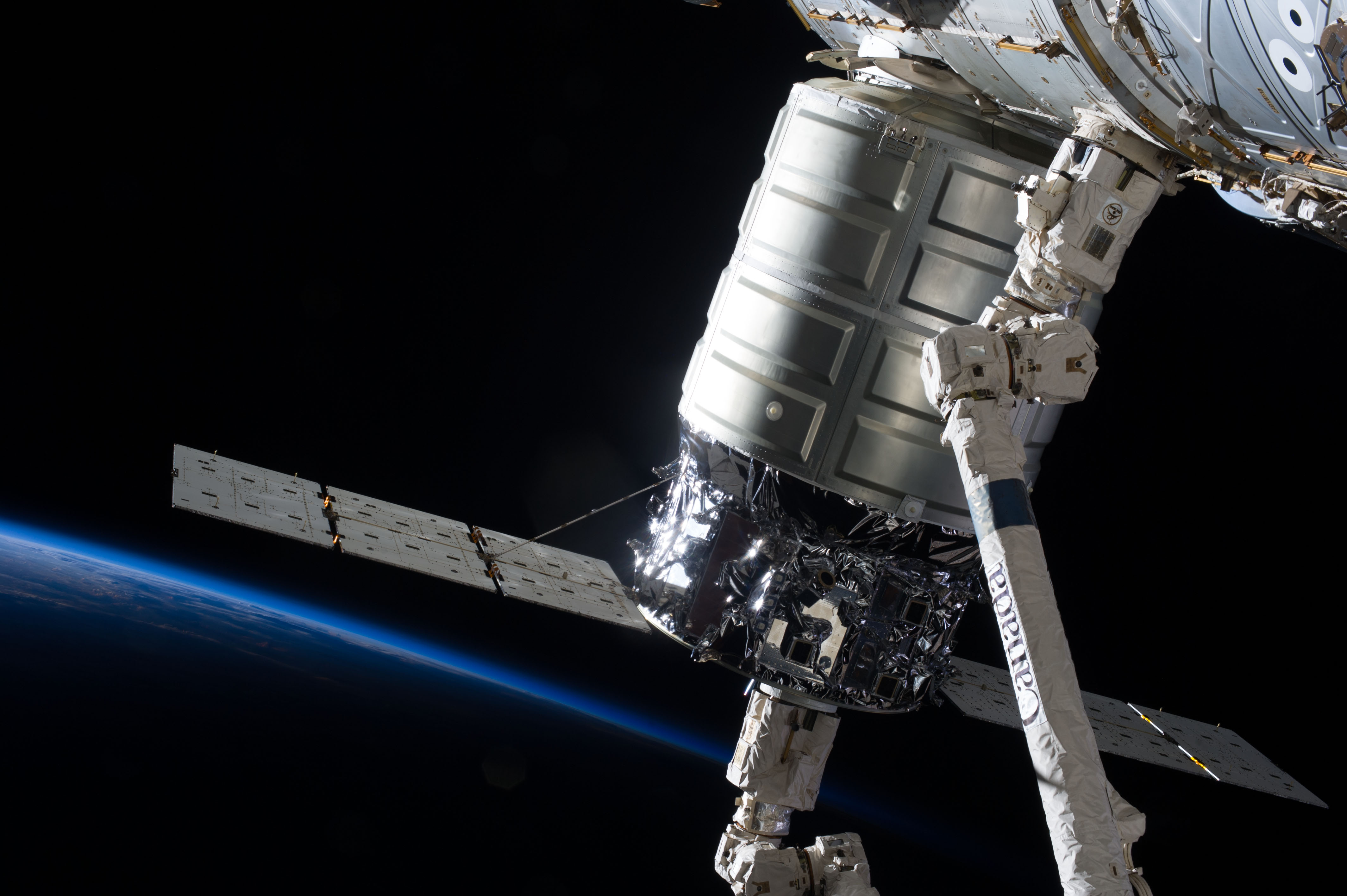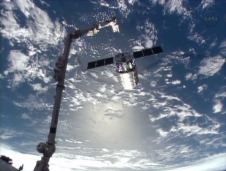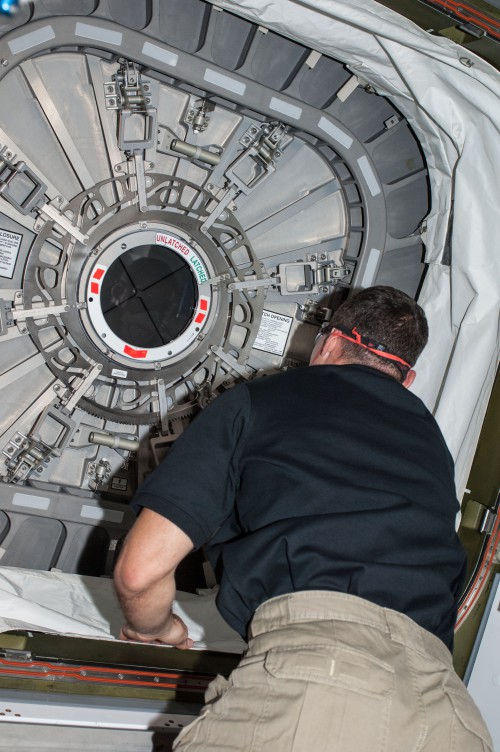
Three weeks after its triumphant arrival at the International Space Station (ISS), Orbital Sciences Corp. and NASA bade farewell to the first Cygnus commercial resupply vehicle earlier today, with a perfect unberthing and departure from the Earth-facing (or “nadir”) port of the Harmony node. Grappled by the 57 foot (17 meter) Canadarm2 robotic arm, Cygnus—which is now into the home stretch of Orbital’s highly successful Demonstration Mission, designated “ORB-D”—was physically separated from the space station and released into free flight at 7:31 a.m. EDT Tuesday, 22 October. It will now guide itself toward a destructive re-entry, high above the Pacific Ocean, which is anticipated Wednesday afternoon.
Preparations for Cygnus’ departure have been ongoing for some time, with Expedition 37’s U.S. Orbital Segment (USOS) crew members Karen Nyberg and Mike Hopkins of NASA, together with European Space Agency (ESA) astronaut Luca Parmitano, undergoing generic training in recent days. Yesterday (Monday), hatches between Cygnus’ Pressurized Cargo Module (PCM) and the nadir port of the Harmony node were closed, leak checks were conducted and power from Canadarm2 was applied to the cargo ship.Today’s unberthing operation was performed from the Robotic Work Station (RWS) in the station’s multi-windowed Cupola, under the supervision of Nyberg and Parmitano. One of the final steps was to command the release of 16 bolts which had earlier been driven after the cargo ship’s arrival on 29 September to rigidize Cygnus against Harmony’s nadir Common Berthing Mechanism (CBM). In the immediate aftermath of physical unberthing, Nyberg and Parmitano maneuvered the cylindrical vehicle to a release distance of 35 feet (10 meters) and at 7:13 a.m. EDT Orbital Sciences—which is tasked with staging eight Cygnus missions by 2016, under the provisions of the $1.9 billion Commercial Resupply Services (CRS) contract with NASA—tweeted that its beautiful baby swan was in “free drift”, ready for release.

The exact timing of Cygnus’ departure was partially based upon lighting conditions and occurred shortly after orbital sunrise. At 7:31 a.m., Canadarm2’s wire snares released the cargo ship from their grasp, ending almost 23 days of joint operations. In the seconds which followed, Nyberg and Parmitano issued a planned “Abort” command, which instructed Cygnus to retreat away from the space station. “Farewell to #ISS from #Cygnus team,” Orbital touchingly tweeted, as the vehicles drifted apart into the inky blackness of space. Laden with almost 3,000 pounds (1,360 kg) of trash and other disposable items, Cygnus transferred to its internal power supplies, which will guide it into a “disposal corridor”, preparatory to its 7-minute de-orbit burn on Wednesday afternoon.
Barely 3 minutes after release from Canadarm2, Cygnus had passed beyond the critical 660 feet (200 meter) “Keep Out Sphere” (KOS), a virtual exclusion zone around the ISS, and by 7:37 a.m. it had completed a separation “burn” of its maneuvering thrusters to commence its relative departure from the vicinity of the station. According to NASA, the ship will fire its engines at 1:41 p.m. EDT Wednesday and burn up somewhere over the Pacific, to the east of New Zealand, at about 2:18 p.m. Unlike SpaceX’s Dragon cargo ship—which can survive atmospheric re-entry and perform a parachute-assisted ocean splashdown—Cygnus is intended to burn up at the end of each mission.
“Congratulations to the teams at Orbital Sciences and NASA who worked hard to make this demonstration mission to the International Space Station an overwhelming success,” NASA Administrator Charles Bolden said. “We are delighted to now have two American companies able to resupply the station. U.S. innovation and inspiration have once again shown their great strength in the design and operation of a new generation of vehicles to carry cargo to our laboratory in space. Orbital’s success today is helping make NASA’s future exploration to farther destinations possible.”
Today’s departure marks the successful completion of Orbital Sciences’ Commercial Orbital Transportation Services (COTS) commitment, clearing the way for its first dedicated resupply flight, under the CRS contract with NASA, which was signed back in December 2008. Under the terms of the contract, Orbital will fly as many as eight CRS missions by 2016, with the first mission—designated “ORB-1″—presently scheduled for launch atop Orbital’s home-grown Antares booster on 15 December from Pad 0A at the Mid-Atlantic Regional Spaceport (MARS) on Wallops Island, Va.

It has been a dramatic few weeks for the first flight of Cygnus, which is named in honor of the late G. David Low, a former Shuttle astronaut and Orbital senior executive, under whose leadership the COTS and CRS relationship with NASA was conceived, matured and reached fruition. ORB-D got underway on 18 September, with the spectacular launch of Orbital’s second Antares rocket from Pad 0A at the MARS site, but the cargo ship’s planned four-day flight profile to reach the ISS on 22 September was repeatedly delayed. The first rendezvous attempt was called off, when “Orbital…established direct data contact with the International Space Station and found that some of the data received had values that it did not expect…causing Cygnus to reject the data”. This interrupted the rendezvous and a 48-hour delay was imposed, but the impending launch of the Soyuz TMA-10M crew—consisting of Russian cosmonauts Oleg Kotov and Sergei Ryazansky and U.S. astronaut Mike Hopkins—on 25 September forced another delay until after their arrival aboard the ISS.
Eventually, and with perfection, Cygnus completed a smooth approach and berthing on 29 September. Since ORB-D is a demonstration mission, none of the cargo ship’s 1,300 pounds (590 kg) of supplies were of a critical nature, although the criticality of its ten Demonstration Objectives—conducted in the first few days of the flight and during the rendezvous with the space station—were essential for it to be deemed a success. After being berthed at the nadir Harmony port, the hatch into Cygnus’ Pressurized Cargo Module (PCM) was opened on 30 September and the astronauts, wearing goggles and face masks to guard against the danger of atmospheric particulate debris, ventured inside to begin removing payloads and supplies. Mike Hopkins described the smell of space. “Before ISS hatch to Cygnus was opened,” he tweeted, “small area between vehicles was at vacuum, which left a distinct odor.” Inside the cargo ship, touchingly, Orbital had attached a photograph of G. David Low.
By 7 October, it was announced that the Expedition 37 crew had completed the process of unloading cargo from Cygnus and had packed the first layer of waste for disposal, with a second layer in the next few days and a third and final layer planned for this week. Completion of the loading of trash will be followed by the close-out of the PCM, preparatory to unberthing. The conclusion of the ORB-D mission will clear the road for the launch of the dedicated ORB-1 mission on 15 December. According to NASASpaceflight.com, the second Cygnus will rendezvous and berth at the ISS on 18 December and will spend about three weeks in residence, with departure planned for 10 January 2014. Further missions (ORB-2 and ORB-3) are tentatively manifested for launch in May and October 2014.
Want to keep up-to-date with all things space? Be sure to “Like” AmericaSpace on Facebook and follow us on Twitter: @AmericaSpace



